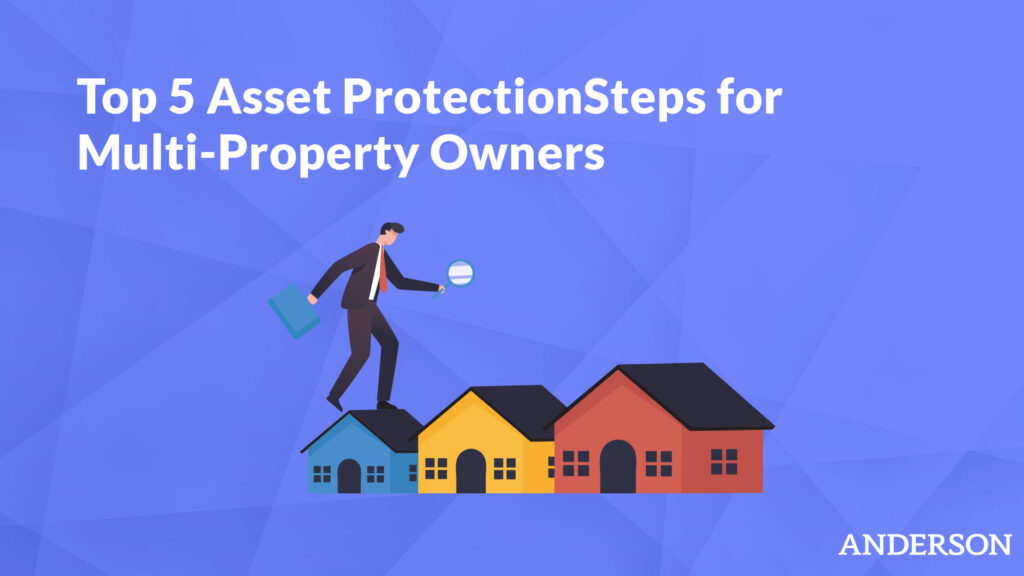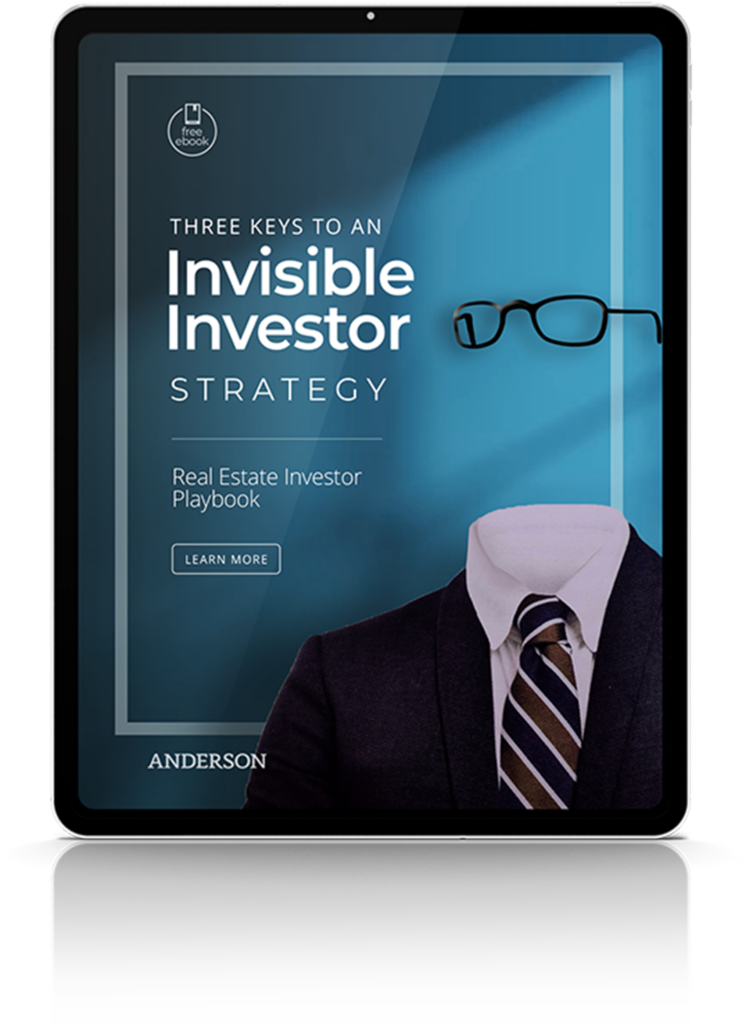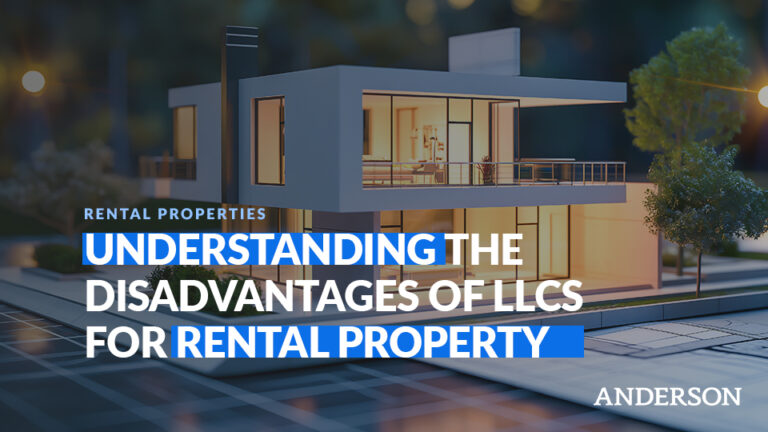
What are funding options for different types of real estate investing? How do you finance deals, and what does it take to put these things together?
Today, Clint Coons of Anderson Business Advisors talks to Kurt Nederveld, CEO and founder of Rainstar Capital Group (RCG). Kurt is an expert when it comes to funding and helps clients gain access to funds that they didn’t think they would have access to ordinarily.
RCG has more than 250 lenders on its debt advisory platform that fund against invoices, accounts receivables, commercial real estate, corporate finance, small business,
equipment and rental real estate.
Highlights/Topics:
- What is RCG’s lending platform? It functions on the four Cs: Cash, credit, collateral, and character via a blueprint of the entire process of accessing all product lines and placing a very high focus on education to grow and create generational wealth.
- What does RCG teach clients? Understand their equity story. If RCG can bring in a higher leverage product, it saves clients/investors the equity.
- What is RCG’s process for doing deals with clients/investors that have little to no cash? Based on cash, credit, and collateral, identify which product lines that they can qualify for from the highest leverage perspective, when you break down the capital stack.
- Can RCG do a blanket loan, cross-collateralize assets to take some cash out to roll into a client’s next deal? The ability to grow is limited by your equity. RCG analyzes which properties have the most equity and whether to do individual cash out or refinance.
- What if somebody wants to do traditional house hacking or they’re going to be renting out rooms, how would that work with the lenders? Currently, the VRBO and Airbnb strategy is the greatest disruptor in the marketplace. Know your local market and drivers.
- What about flipping? Does RCG have products/strategies for those who want to flip properties? There’s either build-to-sell or build-to-rehab-and-rent models. From a mission perspective, families need homes.
- What is Kurt doing right now in the market? Where does he find most of the money? What type of deals is it chasing? Multifamily and single-family rentals are hot. People always need a place to live. The biggest battle is a lack of inventory.
Resources
Roster List of Top MSAs
As always, take advantage of our free educational content and every other Tuesday we have Toby’s Tax Tuesday, a great educational series. Our Structure Implementation Series answers your questions about how to structure your business entities to protect you and your assets.
Additional Resources:
- Claim your FREE Strategy Session, and learn how Anderson Advisors can protect your assets.
- Join our next Tax & Asset Protection event to learn more advanced tax minimization & entity structuring strategies
- For all things investing, check out the Infinity Investing YouTube channel
- Subscribe to our YouTube channel to make sure you never miss the latest strategies & updates
Full Episode Transcript:
Clint: Hey, guys. It’s Clint Coons and in this episode what I wanted to do is talk about funding options for different types of real estate investing. A lot of you that watch my channel, you’re coming here because you have single-family homes, you’re into short-term rentals, you’re into flipping properties, and some of you are into new construction and land development.
A common question I keep getting is how do I finance these deals? What does it take to put these things together? What I thought I would do is bring on someone who we at Anderson, a person we work with, and refer our clients to that is part of our funding communities helping out hundreds of our clients gain access to funds and ordinarily they didn’t think they would have access to because their local lender was telling them we can’t do that deal.
I don’t like to work with people who are saying no. I like to work with people who say yes. The person I have here is Kurt Nederveld of Rainstar Capital Group. He’s the CEO, he’s the founder, and he’s an expert when it comes to funding. Kurt, thanks for coming on.
Kurt: Thank you, Clint. I appreciate the opportunity to speak with you and your audience and am excited to spend this time together.
Clint: Awesome. Let’s just jump right into it. Before we do that, why don’t you tell people how you even got started in the funding business? You’ve been doing it for a few years, but there’s a story there that I think people want to hear so that they get a sense of who you are and your approach to helping out investors?
Kurt: Yeah, for sure. Thank you for this opportunity. I launched Rainstar Capital Group eight years ago in January of 2014. Prior to that, I had launched a marketing firm for Rainstar Marketing, about three years prior. The marketing firm went out to serve about a hundred clients that were primarily funded managers, direct lenders, and commercial real estate—corporate ads. While I love marketing, we did a ton of email and PR news releases. What we got really known for doing LinkedIn marketing.
I started to realize I was in the wrong business because I learned about the money that was being made on the direct lending side and then also on the capital advisor side. I always joke that the marketing firm gave us a huge advantage into the business that we have today, but it was like the internship. This was like playing on the football field.
Since launching Rainstar Capital Group, we’ve been blessed to transact in over a billion dollars worth of financing. We’ve grown as a company. We’re in 12 different locations across the United States. We’re just sort of 40 employees and we’ve built this all-encompassing lending platform.
We have 250 registered lenders on it that are all banks, hedge funds, private equity firms especially finance firms. We provide for our client’s commercial real estate, corporate finance, small business and equipment financing solutions.
We, for the better part of eight years, have been at all of the capital marketing conferences. You can see my […] we’ve had too many state dinners going out and hot diving with all our lenders. What we did was assemble all these lenders onto one easily used platform for areas, then we divided it into an A, B, C, and D lender model. Because of all of the lending, it doesn’t matter if you’re doing a quick loan, it doesn’t matter if you’re financing a rental property or an office building, whatever the loan is being made for, it’s all a function of the three Cs—cash flow, credit, and collateral. You can also add character to that as well.
What we’ve done at Rainstar that our clients just absolutely love is we blueprinted the entire process of accessing all these product lines. Along those lines, we’ve also placed a very high focus on education. Something as complimenting you before we started this video. For your firm, have placed a high focus on education. We’ve shot over a thousand videos that we have on the internet and these videos are very much focused on the strategies that either the business owner or the real estate investor can apply to go use these different products to be able to grow.
If you see a lot of our marketing plan, we’re all about growth capital. If you’re a real estate business, whether you’re on the residential side or if you’re on the commercial side, what you care about is growing your portfolio. Growing your portfolio creates stronger cash flow and at the end of the day, you’re building that wealth for your family. You’re creating that generational wealth that […].
With our platform, it’s great because we have all the solutions. If you go to our website, we launched our own magazine called Rainstar Capital Group Ultimate Lending Guide about six years ago. The magazine highlights, for all our clients all, of the different lending products based on the credit scores, the revenues, and the LTDs. It literally breaks into all of our categories and clients can check that out.
Over the years, they found that to be a huge tool. Let’s be honest, sometimes going to get financing is like speaking a second language. If you’re a new real estate investor out there, you don’t know what you don’t know and you don’t know all the different solutions out there.
At Rainstar, not only do we have all solutions, but we’ve created an educational platform that shows the investors how to use those solutions. Then finally, our entire team plan is made up of exit bankers. We have former presidents of the banks, we have high-level mid-market CNI, commercial real estate SBA, bankers who then act as the guide to the client to help them achieve their goals.
They come to us on our first call or our first opportunity to meet them in person or at a conference in Zoom. We really understand their story. We understand what it is they’re looking to accomplish. We do an analysis called our debt discovering process, understanding what those three Cs—their cash flow, credit, and collateral. Then we match those three Cs with the A, B, C, and D models.
Obviously, somebody with a 550 credit score, maybe they’ve been hit in the past, they went through a divorce, maybe they had a business go bad back in the way. We’ve all hardships. That’s what life’s about.
My point though is obviously, they’re not going to qualify for A paper. They’re not going to get the 3% or 4% long-term money. They might have to use a B or C lender right now, but what we don’t know over the years, which our clients absolutely love and appreciate, is that in any event that we have to use a B or C lender because they got lower credit or they don’t qualify for paper, what the biggest themes over the years are what we call bridge to bankable.
Bridge to bankable is a huge strategy that we teach our clients where they have to use these B or C paper products. It doesn’t mean they’re not going to be able to get into A paper. It just means a property doesn’t qualify today. It means their credit does not qualify today. Typically, what we do—and I keep joking that we should start a consulting company—is because we give out this free advice and say hey, if your credit score is low, go get a credit card. Or, if the property is not at the stabilization rate and the occupancy level that it needs to be to qualify for the A paper, then here’s what you need to do.
I’ll help you with the B paper lender today, as a bridge financing, then once the property is ready, reach back to us and we’ll get you refinanced into that long-term. Everything that we do is all about walking down the journey with our clients funds.
The beauty of Rainstar is that we could literally take somebody buying a raw piece of land, we can finance that. If they want to go vertical construction or they want to go build a rental property, great, we can finance that. Once it stabilizes, they have a rent […] rate, great, we’ll refinance it, get it into that great 20-year money.
I’m really excited to dive into these kinds of things with you today, but hopefully, that gives you just a little overview of who we are, our track record, and our approach. At the end of the day, what it is really about is that educational component because what I found is that real estate investors just solve problems. They’re figuring out how to get deals done.
My message to all of them is if you have one lender—your local bank—you’re only going to be able to get so much done. If you have a platform of 250 plus lenders, then you have a stronger ability to solve problems. That number one problem, I know we’re going to talk a lot about, is that every real estate investor and developer out there is held back by equity.
You can always figure out how to get senior debt, but the trick is the downpayment money. A lot of what we teach our clients is we’ve gone out and figured out what the high leverage products are. High leverage is genius, it’s the name of the game.
Obviously, there are certain situations where you have to be more conservative, and there’s is nothing wrong with that. If you’re truly focused on growth, you’re held back by the balance sheet equity that you have at your entry-level disposal and second, your durability to raise that equity. Whether it’s from family, friends, whether from high network individuals, whether it’s on a more institutional level or family office.
A lot of what we do when we first meet our clients is to really understand their equity story because equity is really what, at the end of the day, is holding back a lot of these investors from going to 100 units to 1000, 1000 units to 10,000. We actually don’t help with equity, we don’t raise equity for clients, but there are a lot of different very strong strategies that you can use to raise that equity then obviously we can bring […].
[…] We can bring them a high leverage product that saves you the equity. For example, you’re a builder or developer, and you’re going to the […] and have the ability to do projects. Well, we can shave down that equity and put that into a fifth project. That’s a big deal for them. I’m excited to dive into some of these details and go through that. Really what we talk about versus strategy then we can dive into the details of the transaction.
Clint: What I want to know about this say you’re a single-family investor. I’m going to go out and buy a single-family home and treat them as long-term rental. When I started investing in Memphis, Tennassee years ago, I would work with lenders who would come in and finance not only the acquisition, but also, many times, the rehabs as well.
All I had to come out of my pocket were a few thousand dollars, you’ll have some points. Sometimes you even roll the points into the deal, then I would have this property after it got completed—it was rehabbed—that had built-in equity of 20% or 30%. I can then move, as you stated, from that D level. They would refinance me to the A level product so I can pay off that D level that had higher interest rates, sometimes you don’t even have to pay those interest. All of that would accumulate for certain periods of time then I would be in this lower interest rate product.
The question I want to know is do you guys do deals like that? Do you have that process set up? Is that a possibility for a real estate investor who doesn’t have a lot of cash right now but can find a property if it’s in criteria?
Kurt: For the investors that don’t have a lot of cash, there’s a bunch of different strategies. You just hit the nail on the head. You first have to identify—it’s kind of like reverse engineering—what it is that you want to do. You can identify based on the three C’s, the cash flow, credit and collateral, which are the product lines that they can qualify for from the highest leverage perspective. When you break down the capital stack, once you know what that piece covers, then you can figure out what it is that you got to come up with or what it is that amount is.
Over the years, it’s been really neat, because again, as I told you, we don’t provide equity but we’ve created over the years what we call replicable equity. That’s where our other lending platforms are very powerful because, for example, if a client owns a business, we have all these other working capital products. We have lines of credit, we have term loans.
It’s been really neat, because over the years, we’ve actually been able to help them get leverage that they then take that cash plant and plunk it down as their equity, then we bring in the senior debt as well, and so it essentially creates a 100% financing solution.
There’s a ton of different strategies on how to do it, obviously, the first and foremost is identifying where they want to qualify from the three C’s perspective. Obviously, somebody with a 550 credit score is not going to get qualified for the best programs out there.
When it comes to real estate investing, especially in the SFR space, it’s all a function of your personal credit, it’s a function of the property type, it’s a function of the deal that you can buy it at—what you can get the purchase price at. Then it’s about identifying what you were talking about, who are the lenders out there that have the ability to apply their senior debt to the purchase price.
Our best programs, I believe go up to 90% of purchase price and 100% of the rehab and that’s a big deal. Obviously, rehab dollars are where you create that value in the property, that’s where you create the lift. When you do the cosmetic work, when you blow out a wall and you expand, when you add a bedroom and so that’s a trick.
What we’ve done over the years, Clint, is we’ve taught clients about other working capital products such as lines of credit and term loans. We have a very popular credit card program that’s used by a lot of the smaller real estate investors. Obviously, if you have a credit card with a $50,000 limit, $30,000 limit, or $20,000 limit, you can run down the street to Home Depot to Menards or any of the building supply companies. You can purchase the tile, the paint, whatever it is you’re using for the rehab, and you can float that money for 30 days.
Then if you can get that property cosmetically done, get the rehab done, and then get […] then you can take the money that comes in from the senior debt, which is going to be your long-term money, your 10, 20, 30 year money. Then you can pay off that working capital line of credit, or the credit card, or whatever it is that you’re using.
Again, for us, it’s about educating the client on the strategies of what they’re looking to accomplish, but then matching that with the programs and the product lines that are available to them to be able to help them get these transactions complete.
Clint: One of the strategies they tell people that they can set up their business and open credit cards under their business name, so it doesn’t report back to their personal credit profile, run all their rehab work through the Home Depot’s on those business cards. So when they go in for the senior debt there, their credit score isn’t going to show up with all those balances they’re carrying or the trade lines that they’ve set up.
Kurt: Right, which drives their credit score down, which then affects our job when we need to go refinance them. You’re spot on. It’s shifting that overhead or that amount of capital that’s being used that doesn’t adversely affect you. We see this all the time too on the business side of things where the owner floats the company with their personal credit cards.
Big mistake, big mistake, because you can set up, like you’re saying, those business lines or those business credit cards to keep your personal credit intact. Keep it at that 750 or 800 level, and then it makes our job a whole lot easier when we go to refinance you into A paper debt, because you’ve got beautiful credit.
Clint: I hope that what people heard here is that you can get into properties where you only need 10% down in order to get that deal under to be able to buy that property. Then you have lenders that will not only give you the 90% but they’re also going to fund all your rehab work. Of course the numbers have to work out, it has to go through the appraisals.
Then what you said is that once that’s done and all the properties completely rehabbed, then you come in, reappraise a property and you go to an A lender—if you qualify—and you take out that C lender who is charging you a higher interest rate. You get into that more senior level product that you’re going to carry for 20 or 30 years so it frees up cash flow for you.
Kurt: Yeah. You really have to look at the business as it’s about creating a machine. Over the years Clint, we’ve worked with the guys that are just starting out doing one, two, or three properties all the way up to the clients who are doing 30, 40, 50 products. That’s a real business. That’s a business doing millions of dollars of revenue. They’ve got the teams, the infrastructure, and the systems.
If you’re looking to do that, if you’re looking to start out, but then get to that level, you have to understand the capital market space. You have to understand how it is you use these programs to, in a sense, rinse and repeat the process of the take down, the rehab, the fix up, get the renter in there, and get it stabilized. Some of the biggest companies that we serve in this space, that’s what they figured out. They just figure out how they can start using this lender, get that process done, but then a lot of these bigger companies are doing at much higher levels.
To be honest with you, one of the greatest things that all lenders care about is good borrowers with good track records. If you can create that relationship, that’s a huge difference. I want to take a minute to talk to the client about this.
One of the biggest battles that we see is that clients began to hit a ceiling with their local bank. The bank is the first place that a client always goes to for capital, it’s great. They’re A paper, which you’re 3%, 4%, 5%, or 6% of money. It’s the cheapest money. If you really dive into how banks operate, they have to be careful from what’s called a credit limit exposure perspective.
Also some of these banks—it depends on the bank—love the SFR space, single-family rentals, and some banks don’t. Many times, what happens is we’ll get really good operators that have created their phenomenal track record and their story to us and say listen, we’re maxing out our bank. Our local community bank, our local credit union, we’re at $5 million with them. We need to get to $10 million. We need to get to that next level.
When I use the word B paper lenders, people think that that’s more expensive money. You have to understand in the SFR space, we have what I call Alt-A lenders. An Alt-A lender is not a bank, but they still have A paper rates. One of the biggest advantages is that these Alt-A lenders, a lot of them have unlimited capital.
What I mean by that is they want to partner with great operators—great groups that have the ability to execute. Whereas the bank might limit you and give you a ceiling of $5 million, whatever the amount is for that bank, a lot of these other groups that’s their whole business.
I have great relationships with a lot of the ownership groups of a lot of our lenders and they’ll be the first to tell you that’s what they’re looking for. That they just want to rinse and repeat the borrower that they can keep lending to, the client understands their program, the lender understands their business, and then it’s just a win-win. It’s a marriage that gets everybody growing together.
Clint: Okay, let’s assume that I’m an investor and I have eight properties. Each of those properties has about $60,000–$80,000 in equity and each of them are held in separate LLCs. Could I bring those six properties to you and say listen, can we do a blanket loan, cross collateralize all of these assets to take some cash out so I can roll that into my next deal? Does it work that way? Are you able to do that?
Kurt: You have a great point, which is one of the strategies that we talked about with our clients. The ability to grow again is limited by your equity. It’s either the balance sheet equity you have today, it’s your ability to raise it or it might be secretly trapped in your existing portfolio.
What you just hit on is something that we do an analysis of when we first meet a client, whether they have five properties or 50 properties. We go through it and we analyze which properties have the most equity and then you hit it again on the head. You either are looking at doing an individual cash out refinance per property, or for an LLC, or we also have the lenders that will do blanket loans, basically a loan against multiple LLCs. Those are the two big strategies that we also look at first because that’s a simple easy way for you to boost up your balance sheet equity to then be able to grow and access other properties and keep the machine growing and going.
Clint: On a deal like that, what is the typical LTV? How much can I be looking to pull out? Is it going to be 80/20, 70/30, or 90/10?
Kurt: Again, it’s a function of the three C’s, and is a function of the A, B, C, D models. Our highest leverage on long-term debt pushes up to 85%, but that’s obviously for the crème de la crème. That’s where the best of the best borrowers are.
Typical leverage, bridge debts can be in your 65%, 70% range. Obviously, a B, a C, and a D paper bridge lender have to have enough spread or enough margin so that if they do put you into a one year or two year bridge facility, they have to know that the senior debt—the long-term debt which typically pushes the 70%, 75%, 80%, that higher leverage—have a spread there so that they can be refinance. Their bridge deck can be taken out once you’re approved your credit score or once you’ve got the properties fully leased up and occupied.
Understand that the B, C, and D lenders obviously typically go lower leverage because they know that if they’re short-term money, 1-5 years of money, that they have to have a spread in there to be able to get taken out by the long-term A paper lenders
Clint: Got it. If they don’t understand what you mean by that, what he’s saying is that when the A paper lender comes in, there has to be sufficient equity left in your property in order for you to get that deal done. If they took everything or gave you everything, and sucked it all the way up, no way A paper is ever going to take them out and they make their money, these other guys, on the turn.
They don’t want to tie their money up for 30 years. What they want to do is get in, get out, and get paid. They’re going to help you to a point and they expect you then to refinance them so they can start turning their money again.
Kurt: Yeah, which is where our guidance is huge. Let me tell you a story. As I shared with you, going into this year, we launched two new sister companies; Rainstar Capital Development and Rainstar Project Capital. Rainstar Project Capital finances super large transactions, $25 million all the way up to $10 billion. Rainstar Development Capital is specifically focused on the new construction housing sector. The product that we have is fantastic, because it pushes higher leverage, which is a big deal for a lot of these housing developers.
For the housing developers that were financing, we’re doing multi-family. We’re doing new construction, mixed use with a heavy housing component. We’re doing condo towers, senior housing, but not assisted living, the 55 and older, apartments, student housing, and then we’re very big right now into the BTR space—build to rent. That’s where somebody’s building subdivisions.
One of the deals that we did in my backyard in West Michigan was a $33 million deal. The nice thing about that whole process that we did with that developer is they’re building 140 townhomes that they then are going to lease up, rent out, and then they’re going to hold for long-term cash flow. In that process, we were able to bring in the larger senior debt product.
The beauty of the program that we have through rents or development capital is we can push all the way up to 90% loan to cost of these single-family homes or multi-family. Literally, I was on a call yesterday on this, they’re currently at about 40% done of the project. They have been very busy building those townhomes. Our market in West Michigan is super hot so they’re actually at 40% completed, a 100% lease of the 40%. Literally as they’re finishing a home, they’re getting a renter in there.
Then for that client, what we’re going to do is we’re going to refinance them into your long-term 20-year money. We’ll probably either use agency debt and CMBS debts. The rates have gone up obviously because of some of what’s going on in the market for the last 60 days. Before, they’re in the low threes. Then a lot of our clients when they get to that level, they just get that long-term debt locked in and they just have cash flow for those things. That’s an example, for obviously a larger residential product project.
The same thing holds true if you’re just starting out, if you’re doing just a one off deal, a one off single-family home. The trick is to learn how to manage your balance sheet equity so that you’re free to not just do one house, but two houses, or three houses, or four houses.
That’s where these higher leverage products have a huge advantage, especially if there’s going to be some sort of build to sell model or build then rent model where you got a rehab component, where you’re executing and creating value in the property. That higher leverage is a big deal because it allows you to do other projects and other other properties.
Clint: There’s a lot of different investment strategies that are out there. Let’s assume somebody wanted to do traditional house hacking or they’re going to be renting out rooms and they find a property. How would that work with the lenders? Are there certain things—maybe you haven’t dealt with this before—where if they came into Rainstar, they’re looking to get a loan, they say they have this property. They’re wanting $600,000 for it.
With my income, I can only qualify for $450,000 but because I’m going to be renting out three of the rooms, which based upon room rents in that area is going to generate an extra $2800 a month, I can qualify. Are there lenders that would look at and say, yeah, we can do that deal, because the traditional banks are probably not going to do it for them.
Kurt: The Vrbo and Airbnb strategy is the greatest disrupter in the marketplace currently, Clint It is the ability to take a single-family home that you would get $2000 a month, $3000 a month, for and juice up that revenue and juice up that cash flow. To answer your question, we have all the lenders that are beginning to finance the Airbnb strategy.
I highly recommend looking at it. I’ll share with you, as of the shooting of this video, my wife and our kids, we’re here in Scottsdale, Arizona. We’re staying in a Vrbo. We’re on a beautiful […] golf course where they got the championship course, the stadium course.
Literally, I’ve had meetings with a property manager that manages this property that my family is staying in. I’m thinking about throwing a strategy together to start acquiring Vrbo and Airbnb properties. The pro formas that this property manager has shared with me, it’s set. It’s just incredible.
Obviously, you’ve got to be able to be strategic from a marketplace perspective. You have to know your local market, you have to know what the drivers are here. In Scottsdale, obviously, they’ve got world class golf, they’ve got minor league baseball. They just built a huge sports complex down in Mesa. You have to really analyze the local market drivers if you’re going to be executing on Airbnb or Vrbo strategy, but it is genius.
You’re basically taking a home and you’re almost making it like a hotel. When you look at a lot of the marketplaces across the United States, there’s a huge opportunity for this strategy and it’s a disrupter. It’s just like how Uber changed transportation. Airbnb and Vrbo are changing the game and putting a lot of money in a lot of these real estate investors’ pockets.
Clint: What I’m hearing is that if I wanted to use that strategy and I wanted to get a loan based upon the projected income, I’m going to have to bring a lot more to the table as far as a pro forma is concerned. Lenders are concerned that they want to know what that market is about, what similar homes are renting for, how much is being generated so they can have a bigger loan against that. But if you don’t have it, it’s not going to work.
Kurt: The beauty of it, for example, some of the property managers, that I’ve met with here in Scottsdale, there are software’s out there that clients can use. Literally, these property managers, the sophisticated ones, have these software’s that can take a property and they can analyze the amount of rent you can get it for whether it’s a three bed versus four bedroom.
Another big strategy, one of the CEOs—the CEO of the property management firm that rents this Vrbo I’m in—explained that they will strategically figure out how to add a couple of beds. Obviously, we can rent to families. That’s a huge strategy versus just renting out one one bedroom type thing.
Then obviously, if you’re in a Vrbo like we’re in right now, we’re overlooking the beautiful TPC golf course, it has a pool, it has a hot tub, it has all those additional amenities. Those are other ways.
There’s softwares out there that can help analyze that local market, analyze that property, and help figure out the pricing. I guess I knew this, but I didn’t know this, but next year here in Arizona, they’re hosting the Superbowl. A lot of property management groups are telling me the rental rates are going to skyrocket next spring because they’ve got the Super Bowl, which always brings them a huge boost to economic development.
It’s really about understanding the marketplaces. I highly recommend building teams. I’m sure you’ve experienced that building your business. I highly recommend all real estate investors have to build a strong team, whether it’s using a firm like Clint’s, whether it’s having a strong CPA, a strong property manager, or using a firm called Rainstar on the capital market side. It’s about working with professionals. The better team you build, the better you’re going to grow and the faster you’re going to grow.
Clint: Alright. You can do the deals in, it sounds like for the people who want to do short-term rentals and other things that are alternative to the standard. What about flipping? If I want to flip properties, do you have products for those?
Kurt: Yeah, flipping is a huge strategy. Obviously, you’re either running a build to sell model or built to rehab it and then rent a model. Another massive issue going on right now, which is why we started Rainstar Development Capital, is that America has a housing shortage. Good quality, affordable, market rate homes and multi-family are a big, big need that we see across many, many markets.
The ability to go in and purchase dilapidated homes, homes that need cosmetic, homes that need bedrooms and bathrooms added, is a huge need. Literally the reason that we raised the funds for Rainstart Development Capital is because we feel there’s a tremendous opportunity to deploy significant capital. Obviously, that’s our new construction, but the same holds true for old homes.
We see markets across the United States that investors are going in and buying up all the old homes and just pouring rehab dollars into those things. At the end of the day, I think it’s fantastic. I think not only are there huge profits that these real estate investors can be creating, but I also think there’s a huge mission behind it which is, at the end of day, families need homes. The home is the core foundational piece to family life. The ability for these real estate investors to fix up these homes, I think they should be very proud of themselves, just for what they’re doing from a mission perspective.
Clint: What are you doing right now in the market? Where do you find most of the money? What type of deals is it chasing currently? I’m just trying to get a sense for if I’m a real estate investor, who the banks are lending to is probably telling me that’s an area of the market that they feel comfortable with and maybe I should look at that.
Kurt: Obviously, we’re living in a post-COVID environment. It’s probably still around, but COVID was a big disrupter. When you look at the commercial real estate space, obviously, the office space game changed, retail changed. Again, some of what we’re talking about here, multi-family and single-family rentals are hot, hot, hot. People always need a place to live. They might not go into an office anymore to work, but they need a home to have shelter and provide for their wife and their kids.
Anyway, money continues to pour into the SFR and to the multi-family space. Again, we do see some banks that pull out of that. It’s just not commercial right there. There’s not a strong credit tenant like you would get with an office, or a triple net asset, or in any of the property types.
We saw on the commercial side, retail got hit, office got hit, some hospitality got hit pretty hard. When the COVID was first starting, travel dropped. People stopped traveling. We’re seeing a huge bounce back on that. It’s getting back to kind of pre-COVID levels, but that’s kind of the analysis on the commercial side and then single-family and multi-family, it’s hot.
We’re putting our bet around it, but I think the biggest battle that we have is a lack of inventory. A lack of inventory is stemming from obviously the raise and pricing in a lot of these markets because there are shortages, which is where we’re trying to help with regards to new construction.
Second, the rookie or the smaller investor is having to fight the Blackstone’s, the BlackRock’s, the big big hedge funds of the world. Again, why are the groups with institutional money jumping in and buying up whole neighborhoods at a time? It’s because they understand the strength of the homeowner and they understand the strength of the rental market. People need a place to live, which is where that rental demand is through the roof.
My message is if you can play in that space, if you follow Grant Cardone, I don’t know if you like him or not, but why is he going after a multi-family? He’s raising all this money acquiring properties. Why is that? If you listen to what he says, it’s because at the end of the day people need a place to live and they will always always need that, but they might not always need the office building.
I think it’s a very strong strategy from an investment perspective to target the SFR space and the multi-family space. We obviously are focused heavily here at Rainstar on that space. I just think it’ll continue to grow. We see a huge opportunity on the construction side. You see a huge opportunity, if you can get the inventory on the ownership side from a rental perspective as well.
Clint: Are there any states that you don’t loan to or where properties are located?
Kurt: For Rainstar Development Capital, yeah, there’s a couple states that we don’t touch. We’re not big in New York at all because there’s the judicial laws. Most states are covered but we do have a couple that we just don’t touch basically.
If anyone is interested, I’d be more than happy to share this with you. We have a roster list of the top grossing MSA marketplaces and I think that’s a huge thing that most investors need to be really aware of. You need to be following trends.
Obviously, everybody knows that a lot of people are leaving California. Where are they going? Scottsdale, Arizona is huge. Boise, Idaho is huge. Salt Lake City is growing left and right. If you can strategically align your business to ride the wave of where the migration is going, there’s only going to be huge profits that you’ll generate. I’d be more than happy to share that list with you if you want to post it on this list as well.
Clint: That’d be great. We’ll put that in the show notes. This has been fabulous to have you on here. If somebody wants to get in touch with you, what’s the best way to do it?
Kurt: Just go to our website, rainstarcapitalgroup.com. We have a tremendous amount of content. One of the things that we have worked very hard on over the years is creating transparency in the capital markets. When you come to our website, you’re going to see tons of videos, you’re going to see webinars, you’re going to see our magazine. Literally on the capital market section of our website, we list out all the different lender profiles and what they’re looking for from the three C’s perspective.
We, over the years, have really applauded for that focus on education, because again, once the client understands how the capital markets work, it allows them to reverse engineer the results that they want, which is obviously going from one property to 10 properties, 10 properties to 100, 100 properties to 1000. It’s just about identifying how to use these different tools in your tool belt to get the end result.
Clint: Great. We’ll have that link in there. For people that are watching, they want to go to your website, they can reach out to you. Anything you want to leave in passing?
Kurt: No reach out to Clint Coons and his firm, they do an awesome job. We also send clients his way and just proud of you, my friend, for the company built. You and I know how much work it is. I’m happy to do this with you and continue to grow.
Clint: Kurt, thanks for taking time out of your busy day to do this. The people that are watching or listening are going to get a ton of value. Again, thank you very much.
Kurt: Yeah. Blessings to you.
Clint: Alright, take care.












